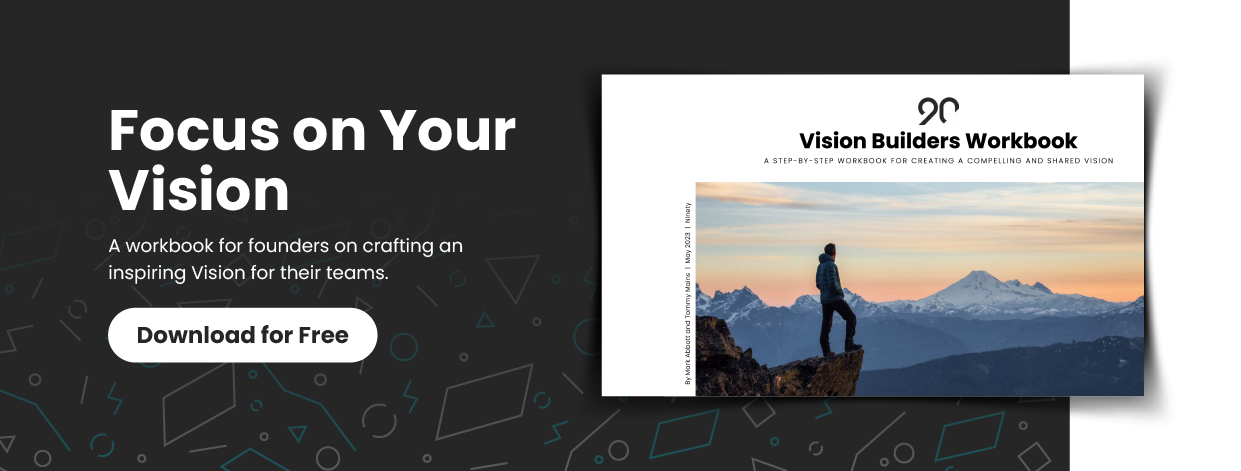Is Your Organization Leveraging Vision Building for Growth?
For decades, top organizational theorists like Jim Collins and Jerry Porras have highlighted the importance of having a vision. All too often, leaders confuse vision with a mission statement, philosophical creed, or the “company way” of doing things. But do these really suffice as a vision?
Collins and Porras explain that an organization’s vision is a compelling, guiding force that grabs attention and galvanizes people toward an audacious goal. Your vision needs to be much more precise, thorough, and empowering than a simple mission statement.
Building a vision that can focus, align, and inspire your team requires intentional effort. As a founder or CEO, you’ll need to take a step back from the daily grind and ask, “Where is our business heading?” and then shape your answer into a clear, compelling vision that has the power to unite your entire organization.
In this article, we’ll share the steps you need to take to build a vision that will excite and inspire your team and all your Ideal Stakeholders.
Table of Contents
- Understanding Vision
- Crafting Your Vision: The Journey Begins
- Establishing Your Focus Filters
- Rolling Out Your Vision
- Building a Thriving Organization with Ninety
Why Now Is the Time to Document Your Vision
Establishing a vision increases your ability to scale your company with clarity, purpose, and consistency. Building your vision will take time, but the impact is worth it.
Schedule a series of four-hour sessions if you can’t afford to step away from daily tasks for a day or more. You owe this to yourself, your Senior Leadership Team (SLT), and all your Ideal Stakeholders.
Your vision includes several Focus Filters to help every member of your organization understand where you’re going, what’s important to you, and how to make decisions that set you up for success.
Who Should Create a Vision?
Establishing an organizational vision is a decisive step to aligning your teams and other Ideal Stakeholders. In addition to the founder's vision, individual departments and teams also benefit from setting a vision of their own.
“Is Vision setting only for CEOs? We don’t think so. Vision setting should take place at all levels of an organization, and each group should set its own Vision — consistent, of course, with the overall Vision of the corporation.”
— Jim Collins and Jerry Porras
If you’re a department or team leader in an organization that hasn’t established a clear and compelling vision yet, our Vision Builders Workbook is for you, too. Download your copy, answer what you can, and start implementing your new team vision.
Understanding Vision
Vision is more than a mission statement — it's the essence of your organization's identity and aspirations. It’s how your team members know who you are and where you’re going. Think of it as your compass for decision-making and strategic planning. A clear vision transforms routine tasks into purpose-driven actions, promoting a culture of engagement and commitment.
Bringing a vision to life takes hard work, but it can be achieved when you follow these steps:
- Establish Focus Filters.
- Communicate the vision with your SLT to ensure alignment.
- Roll out the vision to the entire organization.
- Review and update it where appropriate during your Quarterly Planning Meetings.
- Reshare it every 90 days during your Quarterly State of the Company Meeting.
With an understanding of the vision’s importance and a clear path to its realization, your organization has the momentum it needs for transformational growth and success.
Crafting Your Vision: The Journey Begins
Establishing a vision involves introspection and strategic planning. You’ll need to consider the reasons that spurred the organization’s beginning. You might ask questions like:
- Why did you set out to create the business?
- After a number of positive or best-case scenarios, what will things look like in five years? In ten years?
- What goals can you set, and what are your current priorities to position yourself to make that future happen?
The process can be approached individually, with your SLT, or with the help of a business coach. Regardless of the approach, the key is to minimize distractions and focus entirely on this all-important process.
When you’re ready to begin, take a couple of days to get out of your workspace and away from potential distractions. Bring your printed or digital copy of our Vision Builders Workbook so you can help your vision come to life, getting it out of your head, documented, and ready to share with others.
Establishing Your Focus Filters
Focus Filters are the essential elements of any vision. They include your:
- Industry and Niche
- Ideal Customers
- Compelling Value Proposition
- Core Values
- Compelling Why
- Compelling and Audacious Goals
- Short and Long-Term Goals
We call these elements of your vision “Focus Filters” because they serve as the criteria for evaluating all decisions and strategies. For example, if a company’s Ideal Customers are college students, should the team invest time and money into writing blog posts that appeal to more tenured career professionals? Of course not. Having a clear definition of its Ideal Customer allows this company to align all decisions with a clear vision for the future.
Focus Filters are the guiding principles that align an organization on what matters and serve as the foundation for the vision.
Let’s break each of them down.
Clarify Your Industry and Niche
Define your business's core market and specialization.
Clarifying your industry and niche helps you identify which opportunities to pursue and which to let pass by. When clearly stated, this filter helps everyone in your organization understand and explain exactly what you do.
Identify Your Ideal Customers
Identify and understand the demographics, geographics, and psychographics of your Ideal Customer.
As we’re fond of saying at Ninety, you don’t make money because you want to make money. You make money because someone values what you do.
Determining your Ideal Customer personas — who you serve and why — removes ambiguity from your go-to-market strategy and provides a target for your teams to focus on.
Define Your Compelling Value Proposition
Why does your Ideal Customer choose you over your competitors?
Your Compelling Value Proposition (CVP) is your value creation promise to your customers, usually at least one of the following: lowest cost, continued innovation, impeccable customer service, or gained status. This is what you do to make your product or service compelling to your Ideal Customers.
Establish Your Core Values
Your Core Values are the guiding principles and behaviors your team embodies.
They represent how you and your team members should act. Use your Core Values to aid decision-making, hire new candidates, and celebrate team members.
Find Your Compelling Why
Determine the driving force behind your business: your purpose, passion, and/or just cause.
This filter describes the reason your organization exists (purpose), the powerful emotions that influence you (passion), and a future state so appealing that you're willing to go the extra mile to work toward it (just cause). Finding and describing this Compelling Why offers your team members a way to buy into and participate in your dreams.
Outline Your Compelling and Audacious Goals
Set challenging yet achievable long-term goals.
Compelling and Audacious Goals are bold, ambitious objectives that unite and inspire organizations to achieve greatness. These should be set at least five years into the future, but we recommend ten years. Set your long-term goals to encourage commitment from team members and foster a high-performance culture.
Determine Your Goals for the Next Three Years
Your organization’s leadership team and each department’s leader should determine goals spanning three years, one year, and 90 days from now.
Each of these supports the next tier of goals in the future. Your Rocks (90-day goals) solve problems for you right now and act as an investment in your plans for the year. Similarly, your 1-year goals continue your progress while providing or demonstrating value. Finally, your 3-year goals keep you focused on achieving your Compelling and Audacious Goals.
Rolling Out Your Vision
Once your SLT discusses, agrees, and commits to your organization’s vision, it's crucial to communicate it effectively to the rest of the company.
To align your team members with leadership, share where you’re going, why your work matters, and your guiding principles. Through the vision-building process, you’ve found these answers.
Be sure to welcome questions and address any concerns thoughtfully. This helps generate buy-in from your SLT and the rest of your team, creating vision evangelists and a stronger culture.
Rolling out your vision ensures every team member understands and aligns with the direction and purpose of the company. A clear and compelling vision fosters a sense of belonging and purpose, transforming jobs into passionate pursuits.
As a definition of who you are and a description of your highest aims, your vision may become the deciding factor for candidates considering joining your organization over others.
Typically, a State of the Company Meeting is the best time to share your vision. When we can give our team members work they’re not only great at but also enjoy and believe in doing, we create an organization built to last.
Building a Thriving Organization with Ninety
A clear and compelling vision is the bedrock of a thriving organization. It inspires, guides, and unites everyone toward a common future inspired by purpose and passion. By carefully crafting and diligently implementing your vision, you set the stage for sustained success and organizational excellence.
Our platform can help you every step of the way. You can use our Vision tool to document each element you create while going through the workbook. You have the vision, and we have the tools. Together, we can simplify the hard work of building a great organization. Download the Vision Builders Workbook today to get started.






